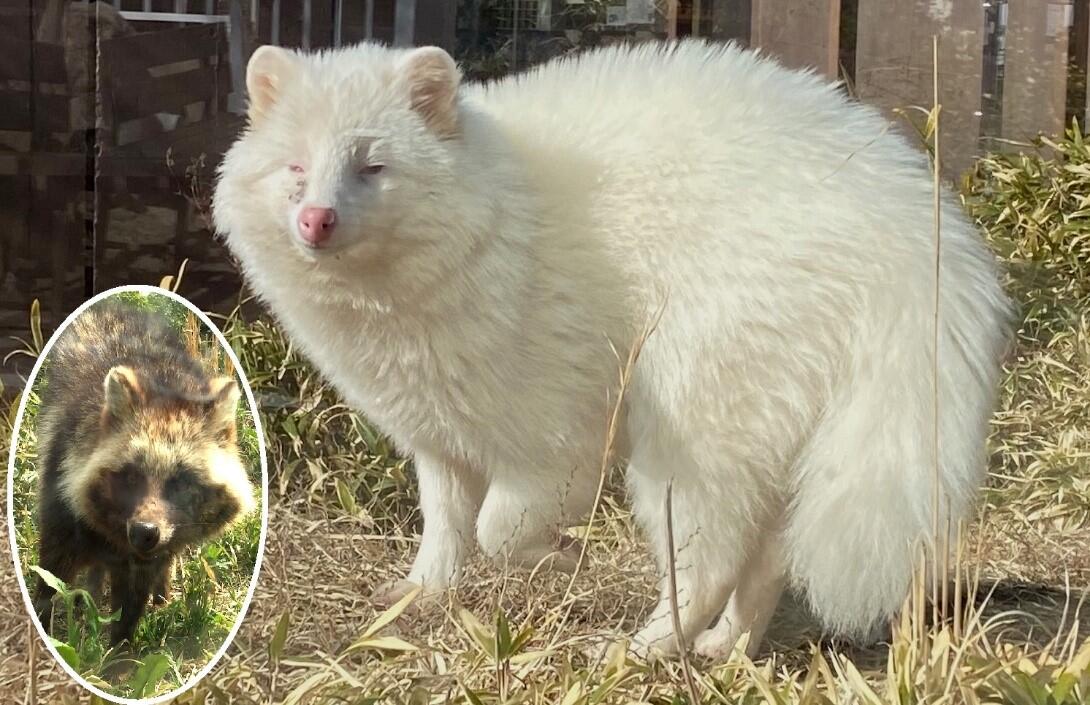The research group led by Professor Akihiko Koga of the Primate Research Institute, Kyoto University, in collaboration with Iida City Zoo and the Gaku Miyazaki photographic studio, conducted analysis of tyrosinase, the gene involved in the synthesis of melanin, in white raccoon dogs, or "tanuki," found in Iida, Nagano Prefecture, and Matsusaka, Mie Prefecture. They announced the finding that the white pigmentation traits of the two tanuki were inherited from a common ancestor. The tyrosinase gene in both tanuki shared the same rare variant causing their albinism. The cities of Iida and Matsusaka are 170km apart in a straight line. This may be the first time in a mammal that the same gene causing albinism has been found over such a wide area. It could be helpful for our understanding of the ecology of wild animals. The results were published in the online edition of Genes & Genetic Systems, the journal of the Genetics Society of Japan.

(Credit: Akihiko Koga, Kyoto University)
Albinism occurs from a lack of pigmentation, due to a genetic mutation related to the synthesis of melanin and is known to be recessive. In the body, melanin is produced through biosynthesis via multiple chemical reactions based on tyrosine. In the central Alps of Nagano Prefecture, white coat, red-eyed tanuki have been observed for decades, and they were thought to have inherited the genetic trait, but this conclusion had not been tested.
In this study, the research group extracted DNA from a stool produced by Ryu, a white tanuki living in Iida City Zoo, and investigated the tyrosinase enzyme gene required for melanin synthesis. A deficiency of tyrosinase is known to be the cause of albinism. Specifically, a key part of the tyrosinase enzyme was cultured by PCR and compared to that of a normal (non-albino) tanuki. Ryu was caught in a trap during a pest eradication campaign by Iida City in 2017 and is currently housed at Iida City Zoo.
The team found a deficiency in the third of five exons in Ryu. Further exploration of the base sequence revealed that of all 529 amino acids of the gene, the amino acids that usually make up the third exon, numbers 347 to 394, were missing. Tyrosinase works because it contains copper ions. Amino acids 363, 367, 389 and 390 - which have a key role in holding the copper ions - were all missing in Ryu. The lack of tyrosinase, therefore, made him an albino. In addition to this deficiency, the team also found a rare mutation with an inversion of about 7kb including the deficient amino acid region.
Likewise, the research group also investigated the tyrosinase gene in Pon, a white tanuki kept at Ouchiyama Zoo after being hit by a car in Matsusaka City, Mie Prefecture, in 2014. They found exactly the same mutation in the tyrosinase gene as in Ryu. As the chances of a coincidental discovery of a completely identical mutation of this rarity are infinitesimal, it is highly likely that Ryu and Pon have a common ancestor.
The distance from Iida, where Ryu was caught, to Matsusaka, where Pon was found, is 170km as the crow flies. If it is true that the mutation was passed down through generations over this distance, it will be the first time that a mammalian albinism gene has ever been found so widely spread. However, human intervention cannot be ruled out.
Albino animals are typically at a disadvantage when it comes to surviving in the wild. Their pale color makes them easy for predators to spot, and the lack of melanin makes them vulnerable to ultraviolet rays, damaging their eyesight and affecting their sense of balance. On the other hand, there have been increased reports of white tanuki sightings, meaning the number of albino specimens may be on the rise. This would tend to support a theory that tanuki are adapting to cities, eating human food waste and using drains for example, thereby easing the conditions for survival.
Koga explains that, "We have only found this in two locations. If we were able to find other tanuki with this gene somewhere else in Japan, this would clearly be a case of widespread dispersion. We are hoping to conduct further study with the cooperation of Ehime University, which has tanuki samples from across the country. If we do find it, that will be clear evidence of urban adaptation."
This article has been translated by JST with permission from The Science News Ltd.(https://sci-news.co.jp/). Unauthorized reproduction of the article and photographs is prohibited.




